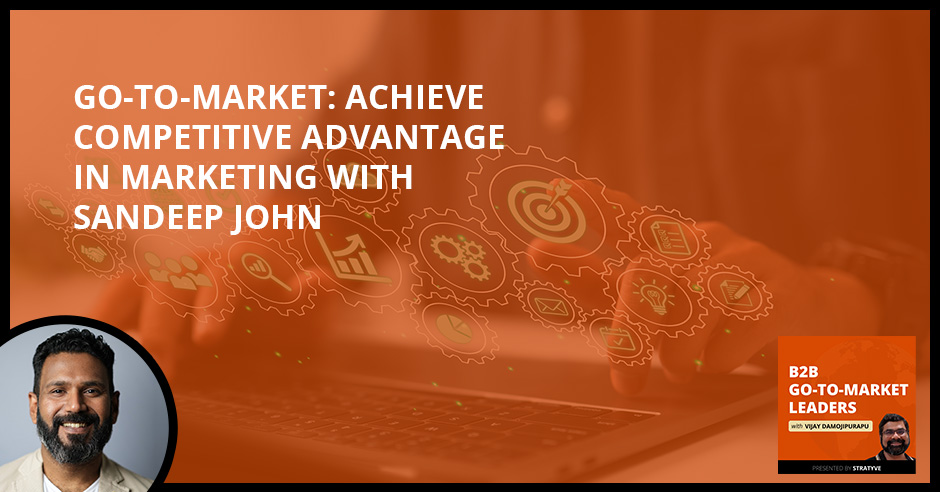

Success in today’s market isn’t about rigid plans, but the ability to adapt and evolve your go-to-market strategy. Our special guest, Gal Aga, co-founder of Aligned, shares his experiences, challenges, and successes in building effective GTM strategies that adapt to changing markets. Gal emphasizes the importance of understanding your Ideal Customer Profile (ICP) and why it’s crucial to niche down before expanding. He further explains how this laser-focused approach can unlock doors to previously untapped markets and foster rapid growth. Discover how Gal moved from traditional direct sales to product-led growth (PLG) at Aligned and the transformative power of shifting strategies in response to market dynamics. In this transition, Gal proves how it requires a flexible mindset and the willingness to unlearn and relearn. So, if you’re navigating the turbulent waters of go-to-market strategies or seeking to redefine your approach, this episode is your compass. Tune in now!
—
Listen to the podcast here
The Aligned Approach: Secrets To Navigating Complex Sales Motions With Gal Aga
Welcome to this episode of the show. Thank you so much for taking the time to tune in to yet another episode, or maybe it’s your first episode. My sincere thanks for that. I have the pleasure of hosting another founder. This time, it’s an Israeli-based startup founder. His name is Gal Aga, and he is based in Israel and is the Founder of Aligned. I’m sure we will dive a lot into his go-to-market thinking and go-to-market approach. With that, welcome to the show, Gal.
Thanks so much. I am excited to be here. Go-to-market is one of the most interesting and close-to-heart topics, so I am very excited to discuss it.
I feel the same here. That’s why you are on this show. I am super excited for that. With that, how do you view and define go-to-market?
It’s one of these things that there are a lot of different versions out there. When you go and start building one, a lot of people put a lot of things into the mix. For me, it’s on a high level first. It’s a strategy or blueprint of how you deliver your product or service to your end users. It involves all of the different elements around it. From who is the buyer persona, which targets or which markets are you targeting, the ICP, competition, your sales motion or sales strategy, how you are going to promote the product, whether you are going to market it, and the pricing element. That’s how I have done it in the past.
It involves all of those things. You did mention about the different functions that you need to work with internally. That’s the product you start with, and then there’s marketing and sales. If you are a SaaS business, there’s the customer success element, which is the wholesale aspect as well. I know you are implicitly referring to it, but at the end of the beginning, it always starts with the buyer and the customer in mind in the go-to-market.
The best ones and the clearer ones that I have seen have always started with the buyer persona, defining all these different people. There is more than one. There’s the decision maker. Who’s the potential champion? Who’s the economic buyer? What are they, buyer persona or end users? From there, it’s easier to build the rest of it.
There is a whole ideal customer profile. It goes at the account level as well as the different stakeholders at the account level and so on, which I’m sure we will dive more into our conversation going forward. This is a great start. Let’s take a step back. Why don’t you tell our audience about your career story exactly why and what got you to the point in starting your startup and what you are doing?
I was fortunate to find my passion early on, which was in sales, and then, at some point, building go-to-market teams or revenue teams. It was then more to the wider scope of go-to-market. I have been in SaaS B2B sales for several years. I took the path from AE to sales manager, sales director, head of sales, VP, and CRO.
I have built. I love building. I was typically very involved early on when you need a lot of methodologies and hands-on strategy. I love building playbooks and go-to-market decks. I have done that multiple times. I had the opportunity to be involved in taking the company from the early stage of $1 million to $10 million. At some point, I also did the $20 million to $100 million range. I was very curious to see how that would work. I started in a telco sales, selling telecommunication technology.
That was Orange Telecom?
Yeah. It was a huge school. I started from the basics. It was before SaaS was something that people even were talking about. I fell in love with sales there and started researching and saying, “I want to build a career there.” There were these superstar sellers there that were selling the more strategic telco equipment. I remember seeing how they were selling, how much they were earning, and the potential.
I started researching and found this thing called SaaS. I researched SaaS and started my way there. My company very quickly understood that this is where I want to be, self-learning all of the insight sales methodologies and all of the SaaS methodologies. At that time, the CEO saw the potential and promoted me to head of sales.
I did, at that point, the decision to go back to selling after building. That was very early. I was building a sales organization myself. I went back to selling and did the enterprise AE path. I wanted to learn from experts. I found someone, a mentor. From there, I went from the sales director, VP sales, CRO, and Aligned. What brought me to found my own company is I knew that it was going to come at some point. Leading, finding more challenges, and doing more things have been my big passion. The opportunity came very early on. I had a passion for sales, so everything got connected. That’s where I am.
You are lucky in so many ways that you found your interest and passion to be in sales from day one of your career. Not many are fortunate. Kudos to you for realizing that and then making the bold steps to seek mentors and create self-learning paths inside sales as well as whom you want to work with. You were even going down the ladder so that you could grow up exponentially in a sales career and sales path. You have done that.
There’s always the notion. It’s not so much where sales or a salesman and salesperson has a very negative stigma, especially if you think of a card salesperson. That’s not the case. We all know that, especially for those who are in the industry. I’m curious. How do your family or your friends describe what you do at work?
The first thing that comes to mind is my son. I love Tesla. I am an Elon Musk fan. I was talking with him a lot about Tesla. He is interested in Tesla. He chatted with me a lot about the potential and the idea. At some point, I explained in one of the chats about the stock market. He describes to his friends, “My dad is Gal Musk.” My son already knows how to say it, but I’m far away from it. Hopefully, one day, I will come close.
It’s interesting how the kids perceive and what type of monikers they bring or gives to the parents when they learn what they are doing at work. Coming back to Aligned, you started Aligned clearly because you were motivated by what you have done in sales. There have also been the gaps that you started seeing while growing up in a sales career. What is Aligned about? What are you trying to solve and for whom?
Aligned is a customer collaboration platform that helps revenue teams better manage the complexity of their deals and their customer success projects. Think about a typical sales process or onboarding process where you have more than 1 or 2 calls to close that is not very transactional. Your customers are juggling a lot of different email threads, e-links, attachments, and tools you can get to mutual action plans in a spreadsheet.

There are a lot of these different things all in attempts to go and enable a champion to sell for you internally or to enable multiple people to get what you do or get your offer. It brings all of these elements into a single collaborative customer-facing workspace where you can centralize all resources, mutual action plans, and key discussions with the customer.
It is a single link instead of all of that back and forth. Everyone involved in the deal can stay on top of the next steps and timelines. Stakeholders always have everything in front of them. It helps your champions sell free internally when you are not in the room. It helps sellers access more stakeholders. It helps keep onboarding or a sales process on track. It helps your action plans. It helps you sell smarter by also analyzing buying behavior in that workspace. That’s pretty much it. Overall, it reduces churn and closes more deals faster.
What prompted you to come up with or pursue this idea in the first place? Why this?
Specifically in my sales career, I have focused on the complex selling motions more like mid-market sales or getting a new startup off the ground, pioneering into a new category where you need to do a lot of why do anything, why ask stuff, excelling, and challenging. One of the cofounders, also named Gal, used to work together at the same company called Syte. It was a very complex sales motion to the retail tech.
We were hiring AEs. I was seeing all the time in my mind what makes a difference between the top sellers and the rest. It was a huge difference. The top sellers were doing $500,000 deals and $700,000 a quarter. Most of the reps were either 70% of target or some of them hitting $100,000. It was a huge difference. I remember one of the reps was closing a deal. She was doing a lot of things in that deal where she wasn’t selling. That was the a-ha moment. We saw that she was not selling. She was curating a buying experience and making it easy for the champion to sell for her while she was not there.
It was all about educating and bringing success criteria formats, building decks, putting in the decks throughout the process in a lot of the next steps and timelines, and updating the decks. She was summarizing all the time the next steps over email. She was creating a mutual action plan over email. A lot of the time, email summaries that mutual action plan.
We saw that, and a few years later, Gal opened a line together with Yotam, our third cofounder and CTO. He always had that dream to open after Syte. I was a CRO at that time. When they started Aligned or started thinking about the idea, he brought me as an advisor. We look back and remember that we knew we wanted to do something in sales. We looked back at these experiences and said, “That’s it.” We researched it more and saw that buying is getting more complex. Buyers are shifting away more from the seller. Gartner is writing about this all the time. Only 5% of the buying journey is spent with the seller. Meaning, most of the time, sales happen when you are not there in the room during the sale.
When we look at how selling happens, it has not changed for years. The sales stack is bloated, but the actual selling and execution of the deal, not emailing and getting pipeline. The actual deal management is still PDF, PowerPoint, or Excel while you have Miro workspace, Slack, Notion, Figma, and workspaces for collaboration in every other area of this. That is the inspiration and motivation. That’s the long version of the story.
The term that caught my attention and which should resonate, and maybe you should use it in your positioning and messaging if you are not already, is curating a buying experience. That’s key. You revealed the playbook of top sellers. That lady was not selling but made it easy for the internal champion to “sell internally” on her back.
That’s what it’s all about. With the budget scrutiny and especially everything that’s going on, if you are not doing that, it’s so easy to choose the status quo. It is so easy for the CFO to challenge your business case when you, as a champion, go there. If you have not been enabled throughout the process, if you don’t know the answers to everything, and if someone didn’t support you, you are going to get stuck as a buyer.

That’s the origin of Aligned. We all know that developing the product and having a hypothesis is one thing. How was the early days? I believe the company was incorporated in 2021 or 2020, depending on where you look at all the legal aspects and things like that. How were the early days? What is the hypothesis around the ICP? How has that evolved?
In the early days, we made a mistake there. We were thinking already too long-term. We were saying, “This is going to take all over the world. This is CRM level category,” which we still believe it is. We can have CRM level scale, but we were saying a little bit at the beginning, “Anyone that’s selling should be able to use this.” At some point, we understood that the beauty is in going a bit more niche at the beginning and tailoring and doubling down on targeting. We optimized it to not be any B2B, but B2B tech. B2B tech is probably going to have higher complexity in the sale process or early adopters of tools.
Secondly, we were defining what complexity is, so anyone that has more than 1, 2, or 3 touches to close. There has to be either a lot of stakeholders to manage, a deep process like a POC to manage, and a deep onboarding or long onboarding. It could even be a pretty transactional sales process with a lot of content sharing because of a lot of education and enablement. That’s where we narrowed down the ICP.
Your sales team or outbound team is focusing on these in the discovery call and prospecting.
That’s correct.
Let’s go back to our conversation earlier in the show, which is the definition of the ICP and how that has to constantly evolve as you evolve your go-to-market. Thanks for sharing your lessons on how you evolved your ICP for Aligned. Coming back to some of the growth aspects and the growth story around Aligned. Feel comfortable to share only what you can share in a public forum. How has Aligned evolved or grown in terms of funding and fundraising the number of customers, revenue, and even the number of employees?
We closed our seed round in the craziness of 2022. It was July or August 2022. We founded the company in October 2021. We did initially a pre-seed almost a year later. We closed the seed round, and when we closed the seed round, we already had the signed partners and initial revenue. From there, we, a year and a little bit after that, have been growing between 50% to 100% quarter-to-quarter.
I can’t share everything, but we are, at the moment, 17 employees around 10,000 users of the product, and around 150 paying customers. That includes also free users in the freemium. Aligned has actual two go-to-market motions. One is product-led and the other is direct sales. That’s one of the biggest challenges to get off the ground with the product with that go-to-market because you are constantly building both. One is for optimizing. These are the high-level details. Was there anything else that I missed?
You did cover the funding, the number of customers, and the number of both the free trial and the paid user. I appreciate that. You did cover the number of employees as well. That’s fine for a public forum. I understand that. Let’s get into the go-to-market success and the go-to-market failure story. You have seen both. I would like to understand your thought process around how you are managing product-led growth like PQLs, MQLs, SQLs, and so on. That’d be good to dive into as well.
I can start giving a high-level about that first. It’s even three motions. It’s PLG, PLS, and direct sales. I have built three sales go-to markets in the past. The sales part involves the product. It involves a lot of marketing within it. This is the most complex that I have done. When you nail all of them together, they are very powerful. For PLS, a lot of people don’t know that term. It’s Product-Led Sales. That means that it’s not only free users who are converting on their own, but you are using the free pool or free trials. It might be a free trial or a freemium type of model.
The free users involve decision-makers in larger companies that typically might buy a few individual seats. Users will pay out of pocket from small budgets or they will not maximize the potential. You are using that to get to a higher level of authority to build a sales opportunity and do a standard sales process. These are the three things that we are focused on. We have inbound leads and an outbound engine that’s driving demo requests top-down. We have inbound signups that are driving free self-serve deals and the product that sells. We are doing trade shows and driving deals there as well.
We covered both the go-to-market success and the failure story. What can you share from a go-to-market success point of view?
One of the things that come to mind that I can share is around pricing. We realized that we had, in Aligned, only a free and a pro package, and then the enterprise contacted us. We did a big research in the market. We saw that in the entire sales stack industry, there was almost no company that had that initial pricing point for self-service.
We opened $35 on a monthly. We opened that tier, experimented with it, and saw an interesting thing. In the beginning, a lot of people weren’t even buying that. It increased our conversion for the pro, but it created more differentiation. People were safe. They felt safer that there was a smaller one, but they wanted the one with more features. That was a big success.
In terms of failure, it connects a little bit to something that I said earlier. It’s another perspective of it. Our platform helps the entire revenue organization, both sales and CS. There’s even a partnership use cases and some SDR sales development use cases there. We initially looked at and mapped all of these buyer personas and defined them. Think about it. You have AE and VP sales. You have both the end user type of buyer persona and the authority for direct sales. You are looking at AEs, VP sales, CROs, revenue operations, ESMs, and partnership managers. It’s a lot.
We were trying to build it like that initially. It’s very helpful, but then we realized that if we are trying to target all of these in terms of building channels like marketing or sales channels to go to market with, it’s going to be an overkill. In messaging, when you try to better one burdened hand, so you try to get all of them together, you are getting nothing. You are getting messaging that’s too fluffing.
If we're trying to target everyone in terms of building channels, marketing or sales channels, to go-to-market with, it's just going to be an overkill. Share on X
Those were the biggest challenges. It took us a while to figure it out. We are still serving all of them. We are starting in sales. From sales, we are expanding. A lot of times, during the sales process, the sales VP will bring the VP of CS or the CRO will want to buy for sales. That’s the core messaging that we put out there. We do 80/20. We decided to do 80% of sales and 20% of the rest in messaging or effort. The CRO will start up sales. From there, during the sales process, it will expand to others or post-sales, it will expand to others.
This changed everything, both in the simplicity of going to market and in conversion success. Long story short, and it repeats itself, niche down as much as possible and be very accurate with the target market through ICP and then expand over time or find other ways to expand during the sales process or post-sales for expansion.

We keep coming back to that core insight in the go-to-market, which is the ICP. You need to be clear. You can say, “I’m telling to sales organizations,” but that’s such a huge market in itself. You need to hone it down into who within sales. Is it SDRs or AEs? Is it the sales leaders? Is it the inside sales or the SDR leader? Is it the rev ops? There are so many of the personas.
We didn’t even talk about the different segments. We talked about the verticals. You said you are focusing on tech. There are so many industries. Even within tech, there are so many segments in terms of $0 to $1 million, $1 million to $10 million, and $10 million to $50 million or $100 million. There are so many of these segments as well.
I have seen some companies and it’s not my experience but an opinion, narrowing down a bit too much. For example, they are doing something like a specific industry within sales or one very simple and small problem. The challenge is positioning-wise. You might be very accurate, but when trying to do PLG, you want more volume. You want to go to a bigger audience.
Also, positioning-wise, you are, from the get-go, creating positioning of something too small. There’s somewhere in the middle. That’s what we are trying to go after. We are trying to be something that tells a story, tells the vision, talks about the long-term, can move quickly, and is not trying to build all versions at once.
You also mentioned the complexity involved in managing the PLG, the self-serve, versus the PLS, and then the actual direct sales. From a lead gen perspective pipeline and then close, how has that mix evolved for the last couple of months?
It has all been growing. It’s almost impossible to build everything at once. We didn’t try to do the actual at the beginning. We tried to only do and only build the PLG virality to acquire the leads initially and then move quickly to capturing demand, creating demand, and doing thought leadership. We focused a lot on that at the beginning because we wanted to have a very clear funnel. We have people signing up and buying. It is people signing up and us helping them unlock value. It is then getting from there to authority and then building a product-qualified account.
It's almost impossible to build everything at once. Share on XFrom there, there is the sales process. That’s going to be a sales process that’s post-value. It has post-value validation or value realization. You have a team already used it for a while, and then you don’t have a trial through the sales process. We were doing that while we were running referrals a little bit. We had a lot of referrals from VCs and a lot of connections and we were still getting inbound. That was already very hard because it’s a different sales process.
You have the people who started top-down. They have already trying and using your product for a long time. You are going through building business cases at a high level where this helps, doing discovery with the leader, and helping with comparisons, and negotiation. Whereas if you are starting top-down, even not the outbound and putting outbound aside, then suddenly, in the lead process, they were telling us, “I want to go and use the free.”
One of the biggest challenges that we had there was figuring out how to separate the two. It was only the point where we felt that we were executing a different sales process well. With top-down, we are executing in a certain way versus bottom-up. If it’s working and things are closing within a few weeks, then we said, “To unlock growth and drive enough pipeline, let’s also start building an outbound machine.” We were having all of these things together that we constantly worked on and optimized.
It’s a big challenge trying to build.
It’s taking the long road a little bit, but it builds a lot of strength for the company. It’s optimizing all of these small pieces. We are going to market in a lot of different directions.
It’s a big challenge. I was responsible for building a PLG, and a product-assisted sales at a Series B startup last year in 2022. The go-to-market motion that the board and the CEO decided to evolve from earlier was inside sales and closing to inside sales. The decision was made to grow the free trial pipeline and then make it self-serve and a close buy to the free trial. In addition to that, it was to move up to mid-market and then do a sales-led.
It was a mess trying to do all of these in 9 to 12 months. We had a whiplash. It was a challenge to figure out what direction we needed to give to the people on the product side, the marketing side, the content side, and the sales side. Who do we hire from a sales point of view? Is it someone who can do product-assisted sales or someone who can do cold outbound and close, or they bring their book of business and close? It was such a huge challenge. That was a massive failure story in the end. The company had to lay off 80% of the employees because they struggled with all these different go-to-market motions.
How big was the company?
When I joined, it was around 150 employees or so, and then we brought it down to 75. Eventually, they went down to 15 to 20 employees. That challenge is always there.
On one hand, it’s harder to do when you are that big because then, it’s product, marketing, and sales. It is so many things together with a lot of processes already in place, so it is hard. At this stage where we are at, it’s a lot of agility. On the other side, I also wouldn’t recommend going and trying to do what we did unless you have one of the founders that have done sales and built go-to markets in the past.
We had the confidence that we were two founders that have done these things in the past. We had the confidence that we could experiment with this quickly and get to conclusions or do this quickly and bring more strength. It is generally a best practice to try only PLG and then go to PLS. Try maybe only outbound and at some point, later on, add the PLG. If you can be a PLG company, it’s better to be a PLG company from the beginning. That’s always true.
The advice I give to my clients as well as folks who I advise in general is to think about how you build and layer on marketing channels. You need to nail 1 or 2 channels, whether it is LinkedIn, email, or something that’s working well. Maybe it’s SEO or content inbound. Something has to be working well, and then you start experimenting and layering on top. The same thing goes with this. If it’s PLG from day one, that’s fine. Figure it out and go all in into PLG. Fireflies.ai, for example, I had the founder here on the show. They were all into PLG. They have PLG motion. Once you have that going, then you can layer on sales. It’s not to throw things at the wall and see what sticks. Especially for the early stage, you are doomed to fail if you are going that route.
You need to give it time.
This was a great conversation. There are a lot of insights for the audience. Switching gears a bit over here. What are the 1 or 2 go-to-market skills or strengths that people look to you for? Maybe it’s PLG, sales, or fundraising.
It’s a few things. It’s one in the product-led sales that I have been having more people speak with me about. Secondly, it is specifically around the problems that we solve for our product, which is improving sales effectiveness in complex sales motions and how to standardize sales playbooks. We optimize direct complex or direct sales motion. People go upmarket or they go multi-product. They go into a more competitive space. This is where we typically help the most.
You must have had a lot of helping hands, mentors, or resources along the way. I know that you are a member of Pavilion, as an example. You also mentioned early on that you specifically joined the company to get the mentoring experience from a world-class leader. What resources or who are the 1, 2, or 3 people that have played a pivotal role in your career inflection points?
Professionally, there have been a lot of people. It’s hard to pinpoint one sales guru or go-to-market guru. There’s Aaron Ross with Predictable Revenue in the early days, The Challenger Sale, and Never Split the Difference by Chris Voss. There were a lot of these different people. If I can say a few that were the most unique, life-changing, and big dramatic shifts, they are from actual people in the self-improvement space like Tony Robbins and Jim Rohn.
I have been turning personal development into a lifestyle. That’s one of the things that Jim Rohn talks about. Work on yourself more than your job. That’s one of his mantras. That’s a big part of it, following people like that all the time and watching their clips on YouTube. Tony Robbins specifically talks about thinking habits. He talks a lot about thinking. Nothing has any meaning except the meaning you give it, how to control or how you interpret situations, and which labels you are putting on situations.
Work on yourself more than your job. Share on XEspecially as a founder, I had a huge euphoria or huge event and then a few dramatic things going on that take you 180% degrees to the other side. You start telling a story to yourself of, “Everything is going in a bad direction.” You can find how you can flip it and focus on that and how it can turn out for the best. This is one big thing that affected me. The third person is my wife. She is a huge part of my life. She is always listening when I’m down. She knows how to pump me up and just be there.
Family support, for sure, goes a long way. Going to your second point, self-help gurus. As cheesy as they may sound, they play a very critical role. For me, I lean on Tony Robbins and Robin Sharma. There are quite a few. Jay Shetty is the newest one on the block in that relevant space. It goes a long way. Marc Benioff credits Tony Robbins a lot.
For the readers out there, don’t think it’s very cheesy. They play a very important role, all these self-help gurus. It’s more up to you as to what and how you lean and use those resources and coaches. I have a final question for you. If you were to turn back the clock to day one of your go-to-market journey, what advice would you give your younger self?
The answer that I’m going to give applies to a lot of different things in the workplace. It took me time to realize this. I’m very methodological. I like formalized. I like finding the, “This is how it should be done.” What I have learned over time is that any formula that I learned and then swore by, you need to throw it into the trash at some point because there are constant changes.
It is being flexible to unlearn about how go-to-market strategy should look like for a company that does this and that because that changes. I have done public sales and direct sales throughout my entire career. I built a PLG company. People tell me, “Why are you doing PLG? Why are you not doing only direct sales?” It has changed. The world has changed.
I 100% agree with you on that. The ability to question your beliefs when it’s not useful and unlearn and learn new habits is a big secret for personal success. In the early days, I used to focus on being perfect. I was detail-oriented. Being an engineer by tradition in the early days, it was all about that. Especially in the early days, if you are doing early business building, you cannot be detail-oriented, process-oriented, and strive for perfection. That will not work. A great conversation. Thank you for sharing so many of these insights. Good luck to you and the team at Aligned.
Thank you so much. It’s been a pleasure. I enjoyed this conversation.
Important Links
Love the show? Subscribe, rate, review, and share! http://stratyve.com/






